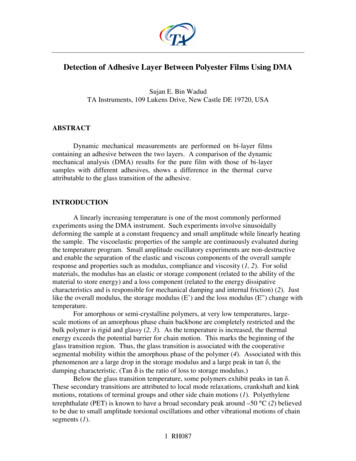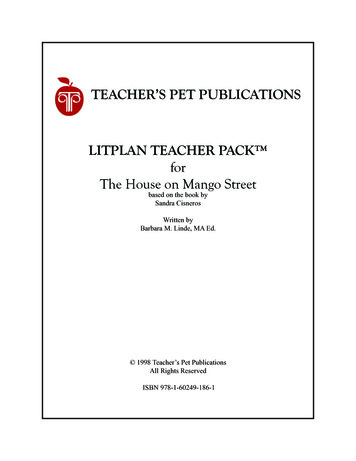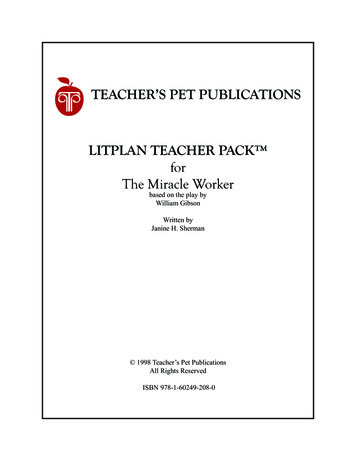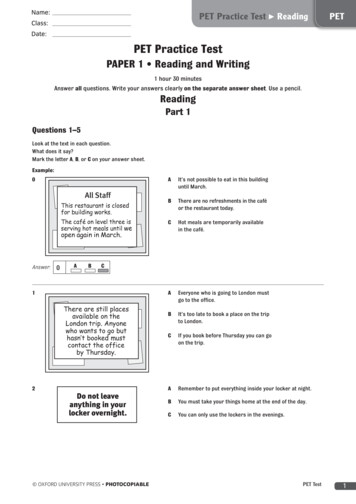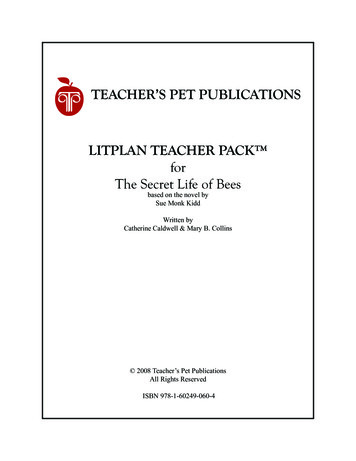
Transcription
TEACHER’S PET PUBLICATIONSLITPLAN TEACHER PACK forThe Secret Life of Beesbased on the novel bySue Monk KiddWritten byCatherine Caldwell & Mary B. Collins 2008 Teacher’s Pet PublicationsAll Rights ReservedISBN 978-1-60249-060-4
TABLE OF CONTENTSThe Secret Life Of BeesIntroduction6Unit Objectives8Reading Assignment Sheet9Unit Outline10Study Questions (Short Answer)13Quiz/Study Questions (Multiple Choice)27Pre-reading Vocabulary Worksheets55Lesson One (Introductory Lesson)81Oral Reading Evaluation Form88Writing Assignment 1113Writing Evaluation Form114Nonfiction Assignment Sheet83Writing Assignment 2118Writing Assignment 3122Extra Writing Assignments/Discussion ?s153Vocabulary Review Activities156Unit Review Activities157Unit Tests163Unit Resource Materials225Vocabulary Resource Materials249
ABOUT THE AUTHORSue Monk KiddSue Monk Kidd was born on August 12, 1948 in Sylvester, Georgia. In 1970 she graduated fromTexas Christian University with a B. S. in nursing.In the mid-to-late 1970's she enrolled in writing classes and started getting published as afreelance writer, writing mostly personal experience articles. She became contributing editor ofGuideposts Magazine.Sue's first books were spiritual memoirs published by Harper SanFrancisco: God's JoyfulSurprise (1988), When the Heart Waits (1990), and The Dance of the Dissident Daughter (1996).In 1997 she began her first work of fiction, The Secret Life of Bees, which was published byViking in 2002. Her second novel, The Mermaid Chair, was published in 2005.Sue Monk Kidd lives by a salt marsh near Charleston, South Carolina with her husband Sandyand a black lab named Lily.Awards2006 Distinguished Alumna of the Year, presented by Texas Christian University2006 South Carolina "The Order of the Palmetto" Award - The state's highest civilianhonor, bestowed by the Governor2005 Winner of the Quill Award in General Fiction - The Mermaid Chair2005 Southeastern Library Association Fiction Award winner - The Secret Life of Bees2004 Book Sense Book of the Year in paperback - The Secret Life of BeesRecipient of the inaugural Literature To Life award presented by The American Place Theatre,New York, NY- 2004Nominated for the 2004 International IMPAC Dublin Literary Award (Dublin, Ireland) for TheSecret Life of BeesWinner of the 2003 SEBA Book of the Year for The Secret Life of BeesFinalist for the 2003 Book Sense Book of the Year Award for fiction - The Secret Life of BeesFinalist for the 2003 Boeke Prize in South Africa for The Secret Life of BeesNominated for the 2002 Orange Prize in England for The Secret Life of BeesWinner of the 1996 Poets & Writers Exchange Program in Fiction for South Carolina1993-1994 South Carolina Fellowship in Literature (Fiction) by the South Carolina ArtsCommissionCitation in "100 Distinguished Stories" by Best American Short Stories 1994 for The4
Secret Life of BeesCitation in "100 Distinguished Stories" by Best American Short Stories 1996 for Inthe Graveyard of Afterbirth1993 Katherine Anne Porter Second Prize in Fiction by the Nimrod/Hardman Awards1994 and 1996 South Carolina Academy of Authors Fellowships in Fiction by the S.C. Academyof Authors1993, 1995 and 1997 South Carolina Fiction Project Winner by the South Carolina ArtsCommission/ Charleston Post and Courier1995 Bread Loaf Scholar in fiction, Bread Loaf Writers Conference, Middlebury, VTNamed to the 1994, 1995, and 1996 South Carolina Readers Circuit1994 Isak Dineson Creative Non-Fiction Award1999 Literal Latte Creative Non-Fiction third prize5
INTRODUCTION The Secret Life of BeesThis LitPlan has been designed to develop students' reading, writing, thinking, and languageskills through exercises and activities related to The Secret Life of Bees. It includes twenty-twolessons, supported by extra resource materials.In the introductory lesson students search for information about topics alluded to in the text, andthey are given the materials they will be using during the unit.The reading assignments are approximately thirty pages each; some are a little shorter whileothers are a little longer. Students have approximately 15 minutes of pre-reading work to do priorto each reading assignment. This pre-reading work involves reviewing the study questions for theassignment and doing some vocabulary work for selected vocabulary words they will encounter intheir reading.The study guide questions are fact-based questions; students can find the answers to thesequestions right in the text. These questions come in two formats: short answer or multiple choice.The best use of these materials is probably to use the short answer version of the questions asstudy guides for students (since answers will be more complete), and to use the multiple choiceversion for occasional quizzes.The vocabulary work is intended to enrich students' vocabularies as well as to aid in thestudents' understanding of the book. Prior to each reading assignment, students will complete atwo-part worksheet for selected vocabulary words in the upcoming reading assignment. Part Ifocuses on students' use of general knowledge and contextual clues by giving the sentence inwhich the word appears in the text. Students are then to write down what they think the wordsmean based on the words' usage. Part II nails down the definitions of the words by givingstudents dictionary definitions of the words and having students match the words to the correctdefinitions based on the words' contextual usage. Students should then have an understanding ofthe words when they meet them in the text.After each reading assignment, students will go back and formulate answers for the study guidequestions. Discussion of these questions serves as a review of the most important events andideas presented in the reading assignments.There is a vocabulary review lesson which pulls together all of the fragmented vocabulary listsfor the reading assignments and gives students a review of all of the words they have studied.A lesson is devoted to the extra discussion questions/writing assignments. These questionsfocus on interpretation, critical analysis, and personal response, employing a variety of thinkingskills and adding to the students' understanding of the novel.There is a group theme project in this unit. This project requires students to study the text forreferences to the group's assigned theme, discuss the theme among themselves using a discussionguide, and present information about the theme to the class.There are three writing assignments in this unit, each with the purpose of informing, persuading,or expressing personal opinions. In the first writing assignment students write a short work ofhistorical fiction using a newspaper or magazine article as a basis for their stories. In the secondwriting assignment students write a letter to send back in time to Lily telling her in detail about anevent or topic that was alluded to in the novel. In the third writing assignment students rewrite thescene when T. Ray comes to get Lily from the calendar sisters, from his point of view andpersuading Lily to return home with him.6
There is a non-fiction reading assignment. Students must read non-fiction articles, books, etc. togather information about topics related to The Secret Life of Bees.The review lesson pulls together all of the aspects of the unit. The teacher is given four or fivechoices of activities or games to use which all serve the same basic function of reviewing all ofthe information presented in the unit.The unit test comes in two formats: multiple choice or short answer. As a convenience, twodifferent tests for each format have been included. There is also an advanced short answer unittest for advanced students.There are additional support materials included with this unit. The Unit Resource Materialssection includes suggestions for an in-class library, crossword and word search puzzles related tothe novel, and extra worksheets. There is a list of bulletin board ideas which gives the teachersuggestions for bulletin boards to go along with this unit. In addition, there is a list of extra classactivities the teacher could choose from to enhance the unit or as a substitution for an exercise theteacher might feel is inappropriate for his/her class. Answer keys are located directly after thereproducible student materials throughout the unit. The Vocabulary Resource Materialssection includes similar worksheets and games to reinforce the vocabulary words.The level of this unit can be varied depending upon the criteria on which the individualassignments are graded, the teacher's expectations of his/her students in class discussions, and theformats chosen for the study guides, quizzes and test. If teachers have other ideas/activities theywish to use, they can usually easily be inserted prior to the review lesson.The student materials may be reproduced for use in the teacher's classroom without infringementof copyrights. No other portion of this unit may be reproduced without the written consent ofTeacher's Pet Publications, Inc.7
UNIT OBJECTIVES The Secret Life of Bees1. Through reading Sue Monk Kidd's The Secret Life of Bees, students will explorethemes of the novel and make connections between themselves and the larger world.2. Students will gain a better knowledge of historical events presented in the novel.3. Students will study the effects of the civil rights movement in the early 1960s.4. Students will study how the characters cope with the situations life throws at them.5. Students will study the elements of connotation and denotation, figurative language(onomatopoeia, similie, metaphor, personification, imagery), allusions, epigraphs,and point of view as related to The Secret Life of Bees.6. Students will analyze how literary elements are used to develop the theme of a novel.7. Students will demonstrate their understanding of the text on four levels: factual,interpretive, critical, and personal.8. Students will answer questions to demonstrate their understanding of the mainevents, characters, and ideas in the novel.9. Students will improve their oral reading skills and individual readingcomprehension.10. Students will enrich their vocabularies and improve their understanding of the novelby using the vocabulary lessons prepared for use in conjunction with the novel.11. Students will read aloud, report, and participate in large and small group discussionsto improve their public speaking and personal interaction skills.12. The writing assignments are geared to several purposes:a. To have students demonstrate their abilities to inform, persuade, express theirown personal ideas, or be creativeb. To check students' reading comprehensionc. To make students think about ideas presented in the noveld. To encourage logical thinkinge. To provide an opportunity for students to practice good grammar and improvetheir use of standard, written English8
READING ASSIGNMENTS The Secret Life of BeesDate AssignedAssignmentAssignment 1Chapter 1Assignment 2Chapters 2-3Assignment 3Chapters 4-5Assignment 4Chapters 6-7Assignment 5Chapter 8Assignment 6Chapter 9Assignment 7Chapter 10Assignment 8Chapter 11Assignment 9Chapter 12Assignment 10Chapter 13Assignment 11Chapter 149Completion Date
UNIT OUTLINE The Secret Life of Bees12345IntroductionAllusion BingoPVR 1Oral ReadingStudy ?s 1PVR 2-3Conotation &DenotationStudy ?s 2-3PVR 4-5CharacterizationStudy ?s 4-5PVR 6-7FigurativeLanguage678910Study ?s 6-7PVR 8AllusionStudy ?s 8PVR 9EpigraphsStudy ?s 9PVR 10Historical ContextPurpose & IntentWritingAssignment #1Study ?s 10PVR 111112131415NonfictionPVR 12Study ?s 11-12PVR 13WritingAssignment #2PVR 14PresentationsStudy ?s 13-14Point of ViewWritingAssignment #31617181920Group ThemeResearch &DiscussionGroup ThemePresenationsExtra Discussion ?sPreparationExtra Discussion?sDiscussionVocabularyReview2122Unit ReviewUnit TestKey: P Preview Study Questions V Vocabulary Work R Read10
LESSON ONEObjectives1. To introduce students to subject matter discussed in the novel2. To introduce students to a variety of media center resources or online research3. To distribute books and other materials necessary for the unitActivity 1Meet in the library or media center.Explain to students that the class will be reading Sue Monk Kidd's The Secret Life of Bees, anddistribute the materials students will use in this unit. Explain in detail how students are to usethese materials.BooksEach school has its own rules and regulations regarding student use of school books. Advisestudents of the procedures that are normal for your school. Preview the book. Look at the covers,front matter, and index.Study GuidesStudents should read the study guide questions for each reading assignment prior to beginning thereading assignment to get a feeling for what events and ideas are important in the section they areabout to read. After reading the section, students will (as a class or individually) answer thequestions to review the important events and ideas from that section of the book. Students shouldkeep the study guides as study materials for the unit test.VocabularyPrior to each reading assignment, students will do vocabulary work related to the section of thebook they are about to read. Following the completion of the reading of the book, there will bea vocabulary review of all the words used in the vocabulary assignments. Students should keeptheir vocabulary work as study materials for the unit test.Reading Assignment SheetYou need to fill in the reading assignment sheet to let students know by when their reading has tobe completed. You can either write the assignment sheet up on a side blackboard or bulletin boardand leave it there for students to see each day, or you can make copies for each student to have. Ineither case, you should advise students to become very familiar with the reading assignments sothey know what is expected of them.Extra Activities CenterThe Unit Resource Materials portion of this LitPlan contains suggestions of topics for an extralibrary of related books and articles in your classroom as well as crossword and word searchpuzzles. Make an extra activities center in your room where you will keep these materials forstudents to use. (Bring the books and articles in from the library and keep several copies of thepuzzles on hand.) Explain to students that these materials are available for students to use whenthey finish reading assignments or other class work early.Non-fiction Assignment SheetExplain to students that they each are to read at least one non-fiction piece from the in-classlibrary at some time during the unit. Students will fill out a non-fiction assignment sheet aftercompleting the reading to help you (the teacher) evaluate their reading experiences and to help thestudents think about and evaluate their own reading experiences.81
WRITING ASSIGNMENT #1 The Secret Life of BeesPROMPTThroughout The Secret Life of Bees, Sue Monk Kidd weaves historical events into her fictionalstoryline. Other writers, such as Dudley Randall, have also depicted social events in a literaryframework ("Ballad of Birmingham"). Refer to the article that you selected from anewspaper or magazine. Your assignment is to use the facts of the article in a work of historicalfiction, choosing your words carefully (using figurative language, connotation, allusions and otherdevices we have studied) to elicit the desired response from your readers.PRE-WRITINGHow might you represent the events of that article through historical fiction? What do you want toconvey to your readers? What response do you want from your readers regarding the issues inyour article? Will you write in prose or poetry? What point of view will you use in your piece?How do you want your readers to feel about the principal characters or events? Think a fewminutes about these key questions and jot down your thoughts.Your work of historical fiction must include examples of at least two different types of figurativelanguage and two allusions. Think about what images or allusions might connect well with yourwork and jot them down.Do you need to make up some additional characters? Maybe you need to embellish some facts?Consider the techniques you might use to strengthen the emotional power of the fictionalizedpiece you create. Make notes of your thoughts on these issues.DRAFTINGUsing your article, your notes, and your thoughts, write a rough draft of your work of historicalfiction. There are many different ways of approaching this assignment, so no step-by-stepdirections are available, but put pen to paper and begin somewhere; you can (and should) alwaysgo back to revise, strengthen, and polish your work.PROOFREADINGAfter you have revised and edited your work to the best of your ability, have someone whoseopinions you trust proofread and evaluate your work. That person should let you know the goodpoints as well as things that could be improved. Consider your critic's opinions and revise as youfeel necessary, making a good, final copy to submit.113
2004 Book Sense Book of the Year in paperback - The Secret Life of Bees Recipient of the inaugural Literature To Life award presented by The American Place Theatre, New York, NY- 2004 Nominated for the 2004 International IMPAC Dublin Literary Award (Dublin, Ireland) for The Secret Life of Bees


